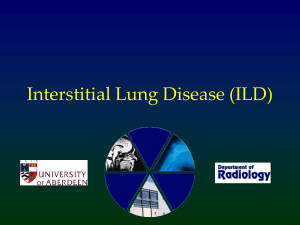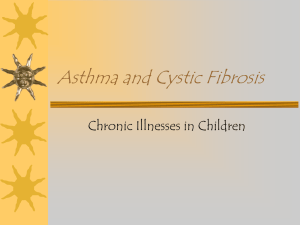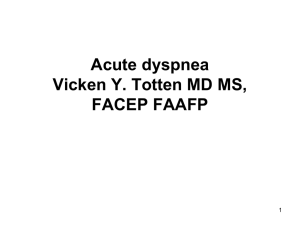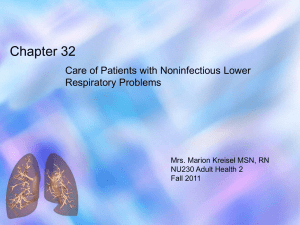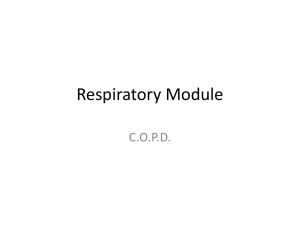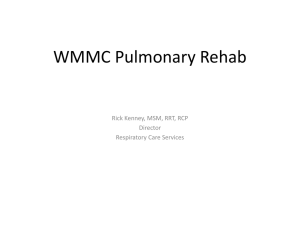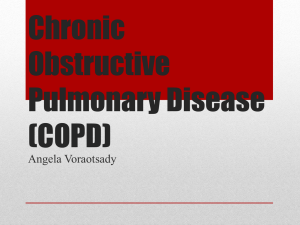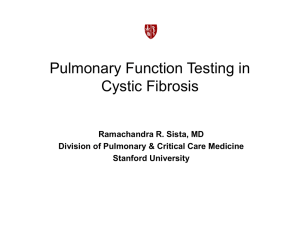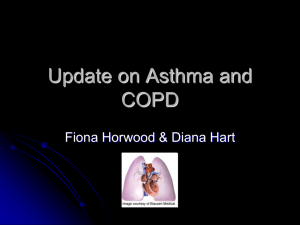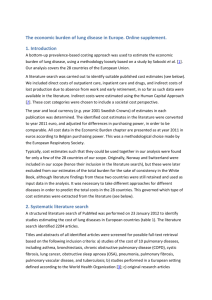RCS 6080 Medical and Psychosocial Aspects of Rehabilitation
advertisement
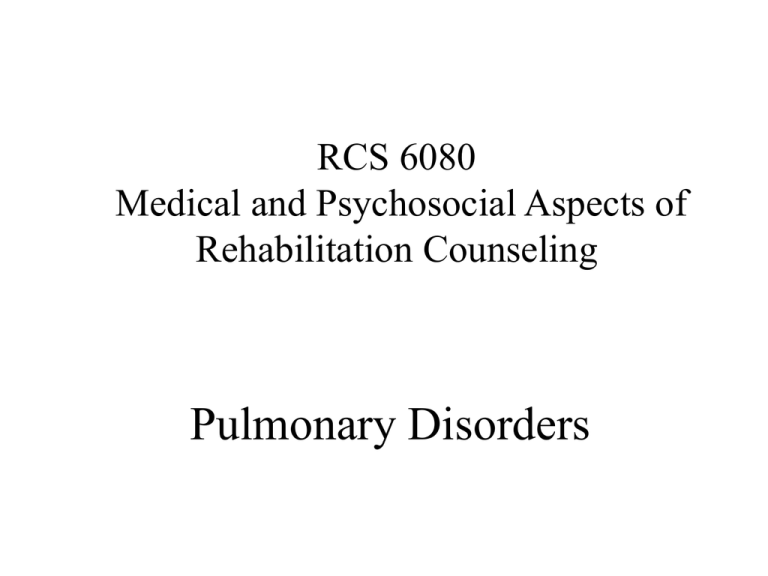
RCS 6080 Medical and Psychosocial Aspects of Rehabilitation Counseling Pulmonary Disorders Chronic Obstructive Pulmonary Disease (COPD) • Characterized by decreased expiratory airflow • Reduction in expiratory airflow has 2 causes: – Decreased expiratory air flow pressure (decrease in driving pressure) – Increased resistance to expiratory air flow (results from narrowing of the airways) Chronic Obstructive Pulmonary Disease (COPD) • Emphysema and chronic bronchitis are often considered together under the term COPD because most people have a combination of chronic bronchitis and emphysema – in other words, most people have both airway disease and alveolar disease • COPD affects as many as 30 million Americans • COPD is the fifth leading cause of death in the US and a major source of morbidity Chronic Obstructive Pulmonary Disease (COPD) • Several factors are involved in the pathogenesis of COPD, but smoking is the most important – Other factors include occupational exposure to dust and fumes and air pollution • In addition to these factors, the development and progression of COPD is largely related to genetic predisposition Chronic Obstructive Pulmonary Disease (COPD) • Two categories of COPD: – Type A: “pink puffer” – considered to have predominantly emphysema – Type B: “blue bloater” – considered to have predominantly chronic bronchitis Functional Disability and COPD • The earliest manifestations of COPD may be relatively mild, but as time goes on, dyspnea becomes the most important limiting factor – Years may pass before the degree of dyspnea is severe enough to limit routine daily activities such as walking – As time progresses, activities such as dressing, bathing, speech, and even eating cannot be accomplished without severe shortness of breath Functional Disability and COPD • Until the disease is extremely far advanced, relatively sedentary activities may be accomplished without too much difficulty • Driving may be possible, but walking even limited distances may not be, particularly if an incline or stairs are involved • Assessment of a given person’s functional capability may be difficult to determine based solely on pulmonary function studies and blood gases Functional Disability and COPD • Depression, fear, and anxiety are potent factors that may further exacerbate the person’s physical limitations • Preparation for a sedentary occupation may be wise even at the time of relatively mild disease because the rate of progression is variable Treatment of COPD • Many people with COPD may have a potential for some reversibility, which can be achieved with proper medical management • Adequate fluid intake and the use of expectorants helps to facilitate the clearance of respiratory tract secretions • Oxygen therapy Treatment of COPD • Chest PT and pulmonary rehabilitation programs are very useful in a variety of ways: – Learn to expel mucus from the respiratory tract – Learn breathing exercises and relaxation techniques that may help in ADLs – Do exercise reconditioning that can help increase endurance and improve work capacity Vocational Implications of COPD • People may have to change their employment goals • The American Thoracic Society divides the degree of impairment by pulmonary function testing into mild, moderate, and severe – Mild impairment is usually not correlated with diminished ability to perform most jobs – Moderate impairment is correlated with a decreased ability to meet the demand of many jobs – Severe impairment prevents the person from meeting the demands of most jobs Asthma • Asthma is now regarded as an inflammatory disease of the airways that is characterized by reversible airway obstruction and bronchial hyperreactivity • The frequency, duration, and severity of the asthmatic attack varies markedly from person to person • Although there are differences from person to person, the asthma attack is typically characterized by shortness of breath and wheezing Asthma • During an asthma attack, the person is totally disabled – Even speech may be impossible – The person may be totally consumed by the effort to breathe and unable to eat or dress – The person is restless and unable to lie flat – Severe cough may produce musculoskeletal pain that aggravates the condition Asthma • Depending on the severity, the attack may be totally or partially reversible, allowing the person to assume normal activities between episodes • People with severe asthma remain symptomatic at all times and resemble people with chronic bronchitis and emphysema with similar levels of disability Treatment of Asthma • Current medical therapy is focused on both the treatment and prevention of an asthma attack – Asthma medications are divided into "controllers" (antiinflammatory agents or long-acting bronchodilator spray) taken on a regular basis and "relievers" (shortacting bronchodilator spray) used as needed • Severe asthma attacks often require hospitalization Vocational Implications of Asthma • In general, a person with asthma should avoid adverse environmental conditions such as outdoor work, temperature changes, heavy particulates, fumes, cigarette smoke, and the like • Physical labor is not contraindicated but should be limited to people with mild disease who are well controlled on medication and under medical supervision • The counselor should interact with the employers to attempt to ensure the avoidance of environmental irritants and to achieve recognition of the person's illness and potential for absenteeism Interstitial Lung Disease (ILD) • A large number of lung diseases involve the supporting structure (interstitium) of the gasexchanging units (alveoli) of the lung and are termed interstitial lung disease (ILD) • One striking common feature among the heterogeneous group of diseases that make up ILD is the loss of lung volume • Often described as "restrictive" lung disease in contrast to the "obstructive" pattern of COPD and asthma Main Types of ILD • Inhalation of organic dusts may result in hypersensitivity pneumonitis – These dusts originate from animal proteins, agricultural products, or bacteria or fungi that contaminate food, wood, or detergents – The illnesses are often named after the occupation in which they occur • Inhalation of inorganic dusts results in pneumoconiosis – Pulmonary fibrosis in pneumoconiosis often occurs 10 to 20 years after exposure began, and symptoms frequently occur after the person has left the occupation in which he or she was exposed • Idiopathic pulmonary fibrosis is a type of ILD in which the cause in unknown Functional Disability of ILD • The common clinical feature is dyspnea • Depending on the severity of fibrosis or inflammation, the person may be symptomatic at rest or only on exertion – Difficulty in walking will often be noted – Simple daily activities of eating, dressing, and bathing may become difficult – Cough may also be a predominant feature – People with hypersensitivity pneumonitis may present with constitutional symptoms such as fever or with wheezing Functional Disability of ILD • Significant psychosocial disabilities may result from severe breathlessness • Anxiety and depression are common, not only as a result of the air hunger but also from the drastic change in lifestyle and activities Vocational Implications of ILD • In the occupational lung diseases, the counselor should work with the physician and employer to determine the offending substances that must be avoided • As in COPD, dyspnea will reduce functional activity • People with severe ILD are typically totally disabled • People with less severe disease may perform sedentary activities but may require shortened workdays or work weeks Cystic Fibrosis • Cystic fibrosis (CF) is a commonly lethal, genetic deficiency disease that is characterized by recurrent respiratory tract infection and progressive respiratory insufficiency • It is estimated that 1 of every 20 people is a carrier of the defect • It occurs more often in Caucasian children (1 in 2,500 births) than in other racial groups Cystic Fibrosis • The disease is usually diagnosed by age 6 and limits life expectancy to 29 years (from text) – Survival into adulthood is increasingly common with medical and scientific advances – According to the CF Foundation's National Patient Registry, the median age of survival for a person with CF is 33.4 years Cystic Fibrosis • The specific gene responsible for CF was discovered in 1989 - but there are hundreds of mutations in this gene, therefore, the severity of CF may vary from person to person • Although pulmonary involvement is the most striking feature of CF, multiple organs may be affected, including the pancreas, liver, intestine, and genitalia Functional Disability and Cystic Fibrosis • Recurrent respiratory tract infection is characteristic of the disease • In children, poor nutrition, slow growth, and delayed puberty are common • The person has a chronic cough, with wheezing and recurrent bronchitis, pneumonitis, and sinusitis • Dyspnea is present and progressive • The pancreatic and intestinal involvement create malabsorption and abdominal discomfort Functional Disability and Cystic Fibrosis • Hepatic involvement creates jaundice and cirrhosis • Sodium loss in sweat may lead to circulatory collapse • There is a considerable variation in time of presentation of these symptoms • Although 75% of people with CF are diagnosed before age 6, they may not exhibit symptoms until adolescence or later Treatment of Cystic Fibrosis • Advances in antibiotic therapy, nutritional support, and chest physiotherapy have markedly increased survival in people with CF • Heart-lung transplantation has been applied to people with CF • People with CF require daily chest physiotherapy to loosen secretions and prevent stagnation and secondary infections • Antibiotics are essential in treating infection, often given intravenously • Nutritional support can also be given intravenously in people who are malnourished Vocational Implications of CF • People with CF have excellent educational success and are typically productive individuals • The counselor will have to work with employers to provide the support mechanisms that will allow the person to remain in the workplace – This may include the provision of time for chest physiotherapy or antibiotic treatment during the workday – The work environment must be reviewed to ensure the absence of irritants that might exacerbate the disease – Supplemental oxygen may be necessary to allow the person the continue to be productive and ambulatory • The counselor can also work with the person's family to improve support at home that will allow the person to increase social and vocational activities Additional Resources and Information from the Web • American Thoracic Society (www.thoracic.org) • American Lung Association (www.lungusa.org) • American Lung Association of Florida (www.lungfla.org) • American Association of Cardiovascular and Pulmonary Rehabilitation (www.aacvpr.org) • Asthma and Allergy Foundation of America (www.aafa.org) Additional Resources and Information from the Web • • • • Allergy and Asthma Network (www.aanma.org) COPD-Support, Inc. (www.copd-support.com) Cystic Fibrosis Foundation (www.cff.org) Cystic Fibrosis Research, Inc. (www.cfri.org/home.htm) • Cystic Fibrosis Resources (www.cysticfibrosis.com) • JAN on Respiratory Impairment (www.jan.wvu.edu/media/respiratory.html)

